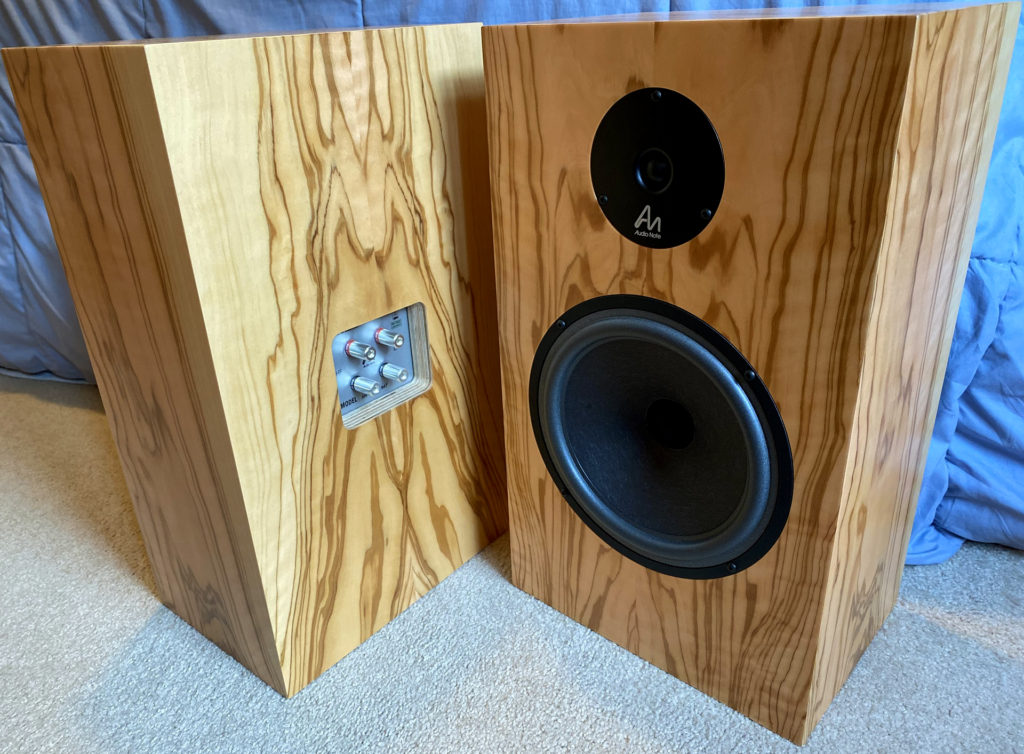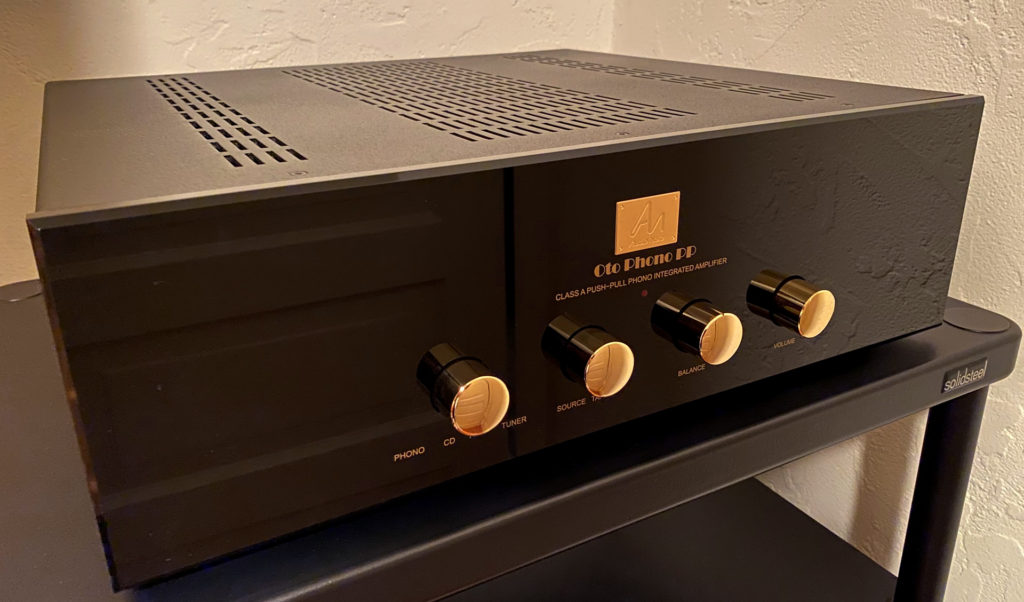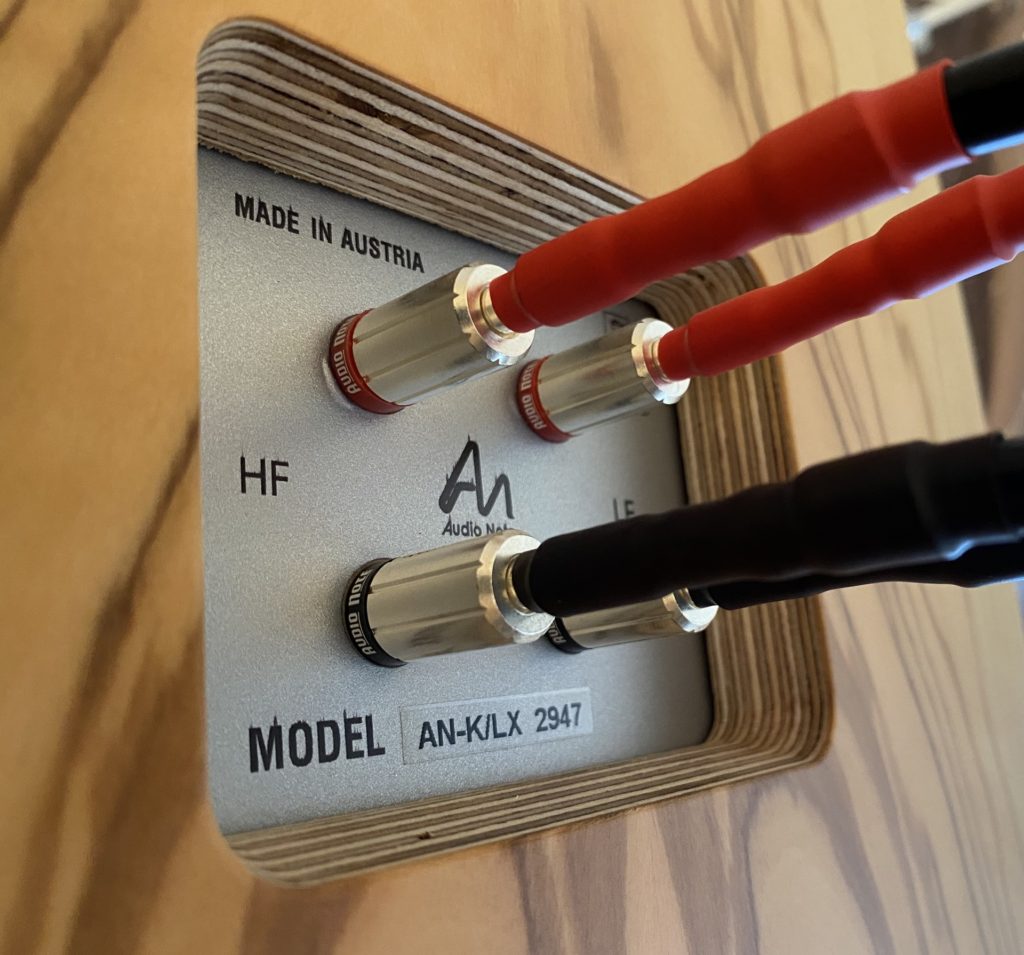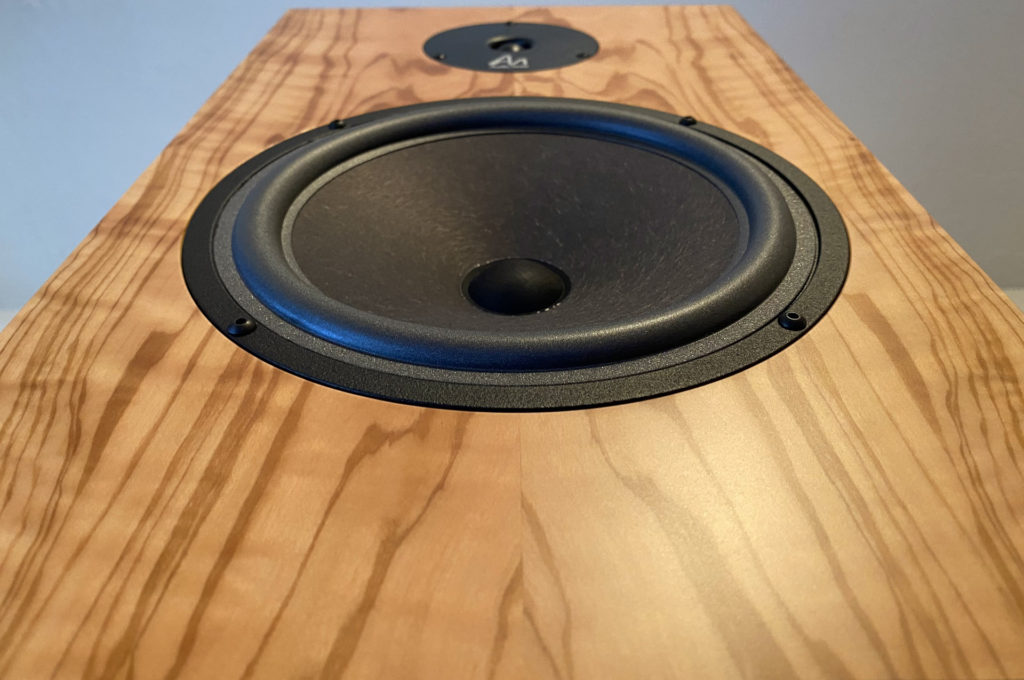
Audio Note UK is a company that marches to the beat of its own drum. The company’s unique and outspoken approach to all things audio has made it a household name among audiophiles and HiFi enthusiasts. Most notable is Audio Note’s healthy obsession with designing capacitors and transformers. This ensures that the company is in complete control of the signal path from start to finish.
What is the rationale behind why a company would choose to manufacture its own capacitors and transformers, versus selecting from the bevy of commercially available options? Finding the answer to this multifaceted question will begin to give you an understanding of the company’s approach toward music and the gear that makes it sound real.
For this Audio Note review, I took a listen to the AN-K/LX speakers ($4,900) powered by the OTO Phono PP tube integrated amplifier ($5,000), connected with a 2.5m pair of AN-Lexus LX Bi-Wire speaker cables ($2,200). My goal was to hear what kind of experience this turnkey “just add music” system provided. Are you ready to dive in and take a closer look inside these components? Let’s find out if their musical performance is more than the sum of their parts.
OTO Phono PP Integrated Amplifier

Weighing in at a respectable but manageable 27 lbs, the OTO PP integrated amplifier uses four vintage General Electric NOS 6005W power tubes in a push-pull configuration to deliver 9wpc. Before reaching the amplifier section, the signal passes through one 5670 General Electric NOS tube in the driver section and two 6UA6 tubes (NOS RCA, Westinghouse, or other) in the preamp section. The discrete phono stage uses one ECC83 (Psvane or Electro-Harmonix) and one 6N23P (Russian NOS) tube.
Four gold control knobs adorn the front of this classy-looking amplifier, which is finished with a highly reflective gloss-black acrylic plate. The amplifier’s complete lack of hum or buzz further demonstrates its physical refinement. There is also no hiss heard through the speakers. Peeking inside through the top vent reveals several Audio Note UK tin-foil capacitors used in both the primary and phono preamps. Due to its Class A design, this amplifier generates plenty of heat, so you’ll want to provide a minimum of 7 inches of clearance above it for adequate ventilation.
AN-K/LX Loudspeakers and AN-Lexus LX Bi-Wire Speaker Cables

My review sample AN-K/LX speakers arrived wearing a stunning olive wood veneer. They are easily the most beautiful speakers that I’ve had in my listening room. These gorgeous works of art immediately reminded me of heirloom-quality vintage furniture that I would be proud to pass down to future generations.
Instead of MDF, the cabinet is constructed of six layers of Russian Birch ply, a wood specifically selected for its acoustic properties. Instead of trying to fight resonances and create a completely inert enclosure, Audio Note embraces the natural resonant frequencies of the cabinet and uses them to enhance the operation of the drivers.
These speakers are the spiritual successor and modern-day interpretation of the vintage Snell Acoustics Type K speakers. While they share many attributes, they are far from simply a clone or re-imagination of the original. Sporting a ¾” tweeter and an 8” paper cone woofer and shipping without grilles, their design exudes simple elegance.
I connected the speakers to the OTO Phono PP with the AN-Lexus LX Bi-Wire speaker cables. These cables consist of 96 strands of high-purity copper, arranged in a Litz configuration. They’re designed with four groups of twisted-quad Litz conductors per cable, so four cables run to each speaker to bi-wire.
Sound Quality and Performance
Despite having “only” 9 watts per channel on tap, there was seemingly limitless power and headroom available. Throughout the several months I spent listening to the Audio Note system, I never felt that I needed a more powerful amplifier. This helped me dispel the expectation that you “must have (100, 200, etc.) watts per channel in order to drive a speaker properly.” For the volume levels I regularly listen to in my 13’x10’ room, 65-85db, 9wpc seemed to work perfectly.
Speaking of volume levels, I found the behavior of the OTO’s unusually sensitive volume knob especially interesting. It was not completely linear, but instead followed more of a logarithmic curve as you turned up the volume. Furthermore, increasing the volume level never gave the impression of the speakers crudely spitting more sound out or becoming unsettled. Instead, the effect was akin to increasing the dimmer switch of a halogen floodlight and filling the center of a room with pleasant but focused light. When I rotated the OTO’s volume knob clockwise, more musical energy simply grew within the room in an organic and graceful way.
The OTO Phono PP powering the AN-K/LX speakers highlighted both the upper midrange and the presence region of the treble. The speaker’s voicing leads with midrange purity and crisp treble taking center stage, with a below-average low-frequency response. Despite the 8” woofer, bass energy was subdued and seemed to drop off quickly below 100hz even with the speakers positioned about a foot away from the front wall.
Pure and Natural Tonality

Instead of the large paper-cone woofer digging deep and being a bass-heavy party speaker, it uses its size and material to portray a pure and natural tonality that presents lifelike images of acoustic instruments and voices. I listened to a wide assortment of jazz piano recordings and was continuously in awe of the tonal accuracy and realism. Instead of making me feel like I was listening to a pair of speakers, the Audio Note system simply let me hear the instruments as they sound in reality.
The tweeter’s forward presentation in the presence region made it unforgiving with modern, post “loudness-war” recordings. If a recording was mastered with bright treble, I heard it. This made it tricky to enjoy some of my favorite electronic music, as I found myself trying to turn up the volume to hear more of the bass energy, only to have the treble energy start to overpower the other frequencies.
Conversely, the Audio Note system scaled up its performance appropriately when I played a higher-quality recording with more dynamic headroom. With audiophile recordings, the tweeter’s treble energy was spot-on and perfectly provided refined high-frequency fill without drawing attention to itself.
Synergy and Musical Experience
As I moved away from synthetic electronic music and dove deep into jazz and classical, the strengths of the Audio Note system began to emerge. Instead of hearing all the typical modern-day audiophile tricks such as 3D imaging with soundstage width and height, I simply heard natural-sounding music filling my listening space. There was a greater emphasis on delivering a fundamental realism versus ticking all my usual audio-reviewer checkmarks.
This style of presentation challenged my typical approach toward reviewing components. The Audio Note system gave me a greater sensation of listening to live music compared to the other equipment I’ve heard. Its underlying substance and moxie will be fully realized when listening to small-group jazz ensembles, intimately recorded chamber music, and other well-made recordings where the emotion of the performance has been captured.
When I switched to vinyl, it only took a few revolutions for me to realize this system was designed for vinyl lovers. There weren’t any glaring shortcomings when I played music from Tidal or CD. I got a distinct impression, however, that Audio Note designed these components for those enthusiasts who primarily listen to vinyl.
The phono preamp section turned out to be my favorite element of the Audio Note system. The built-in phono preamp bolstered the overall tonality in a way that provided a sense of stability and solidity to the sound. However, it did not color or tint the presentation of the recording. It simply took the best elements of vinyl and reinforced them. I’m confident that you would feel the same way after one spin of your favorite record.
Caveats
First and foremost, the OTO Phono PP does not have remote-controlled volume. For some, this will be a deal-breaker. Others may be more forgiving of this antiquated design decision. There is no reason not to offer remote-controlled volume. Even a price increase of $100-200 would be well worth it for the convenience of fine-tuning the volume level from your listening position.
Secondly, I had trouble when attempting to connect the AN-Lexus LX speaker cables to the binding posts on the OTO Phono PP. The binding posts are nearly flush with the back panel, and the cables are terminated with straight spade connectors. This mismatch, combined with the thickness of the cable itself, made it impossible to get the spade screwed down flush and flat inside the binding post. If Audio Note used angled spade connectors or spaced the binding posts further out from the chassis, it would alleviate this issue. As they were provided, the AN-Lexus LX speaker cables were fundamentally incompatible with the OTO Phono PP’s binding posts. I couldn’t make a safe and satisfactory connection without buying a set of rhodium-plated Cardas spade to banana plug adapters. Using these allowed me to connect the cables in a way that met my standards and expectations.
Lastly, let’s address the elephant in the room, the price. At just over $12k for the entire system, this represents a substantial investment for most music lovers. Only you can decide how much you are willing to spend on musical enjoyment. I would suggest a careful audition of an Audio Note system before committing because this sound signature is not going to be for everyone. Like many types of HiFi components, its performance will be polarizing – you’re likely to either love it or leave it.
Conclusion and Value
My time spent with the Audio Note UK system was an enlightening and musically rewarding listening experience. It exposed me to a system that values a natural musical presentation, coherence, and tonal accuracy above audiophile tricks that dazzle in a showroom but then ultimately become tired and grating. Music lovers who have yet to find that elusive live-music quality would be well-served to audition equipment from Audio Note.
Reviewing the AN-K/LX speakers also allowed me to come full-circle with the speaker that originally planted my audio seed when I was a child – my father’s Snell Acoustics Type Ks. Powered by a modest Onkyo Integra integrated amplifier that system captivated my senses, and unknowingly at the time, started my lifelong journey as an audiophile. I’m happy to hear that the captivating tonal character of the Type K lives on in this modern-day interpretation.
If you are looking for a system that values organic fluidity, purity of tone, and honors the core principles of well-recorded music, Audio Note could be your endgame.
Equipment and prices for the Audio Note UK Experience:
AN-K/LX speakers ($4,900)
OTO Phono PP tube integrated amplifier ($5,000)
2.5m pair of AN-Lexus LX Bi-Wire speaker cables ($2,200)
Associated Equipment:
Digital Sources: Auralic Vega G1, Marantz SA-KI Ruby
Analog Source: Technics SL-1200mk2 w/ Ortofon OM-30 cartridge
Power and Interconnect cables: Shunyata Delta v2
Power Distribution: Dedicated 20a circuit, Shunyata PS8 with Venom Defender
Manufacturer’s Feedback from Peter Qvortrup
Thanks much appreciated, a good read as you say! Now to your caveats.
Remote control, it is not correct that incorporating a remote whilst retaining the overall sonic quality of the OTO would add $ 100.00 – 200.00 to the retail, for that what you would get at base manufacturing cost is a digital chip costing about $ 20.00 with some associated parts all of which would degrade the sound enormously (believe me when I say we have tried), if you take a blue Alps motorized volume it would add at least 300.00 to $ 400.00 to the retail and still degrade the sound considerably, not as much as the digital volume control, but still enough to make the OTO far less attractive as a sonic proposition. Just so you know the volume control in the OTO is specifically developed for the best sound quality, as is the case with everything we make.
We value sound over convenience as you know, and unfortunately sound always comes at a price and in our view balancing sound versus cost versus convenience we put the money into improving sound even if it would make it superficially more saleable if the money were spent on convenience.
I cannot argue with the issue you had with the spades, we should have supplied the Lexus with bananas at both ends that would have solved the issue !
Price, it may, as a reviewer, be worth considering that our (and a small number of other manufacturers’ products) hold their value better than most, so whilst the cost of entry is high the return on exit is also relatively high, so overall the actual cost of ownership is not solely reflected in the retail price.
Anyways, your comments are genuinely appreciated and the review is more than fair.

